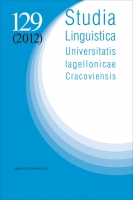The KAŊ verbal form in Basse Mandinka – structure and meaning
The KAŊ verbal form in Basse Mandinka – structure and meaning
Author(s): Alexander AndrasonSubject(s): Language and Literature Studies
Published by: Wydawnictwo Uniwersytetu Jagiellońskiego
Keywords: African linguistics; Manding; Mandinka; verbal system; semantics
Summary/Abstract: The present article rectifies a noticeable lacuna in the analysis of the Mandinka verbal system and offers a detailed discussion of the meaning of the KAŊ locution (i.e. of the analytical expression be + infinitive + kaŋ) as well as a presentation of its most relevant structural properties. First, the author demonstrates that there are no structural or contextual restrictions on the use of the formation. It may be employed in all kinds of environments: transitive and intransitive or affirmative and negative. It likewise tolerates various types of roots, admitting dynamic, static and adjectival predicates. Second, in respect to the semantic content, although the progressive value of the periphrasis clearly predominates various refinements are necessary. The progressive meaning – limited to the present and past temporal sphere – can also be also portrayed as repeated and frequentative. Adjectival predicates are invariably employed with a dynamic transitory-ingressive force. However, certain static verbs employed in the KAŊ form regularly denote continuous situations. Additionally, the periphrasis may indicate general, durative and extended in time activities, corresponding to Indo-European simple tenses. Finally, it also appears with the force of an inclusive perfect.
Journal: Studia Linguistica Universitatis Iagellonicae Cracoviensis
- Issue Year: 2012
- Issue No: 129
- Page Range: 35-48
- Page Count: 14
- Language: English

